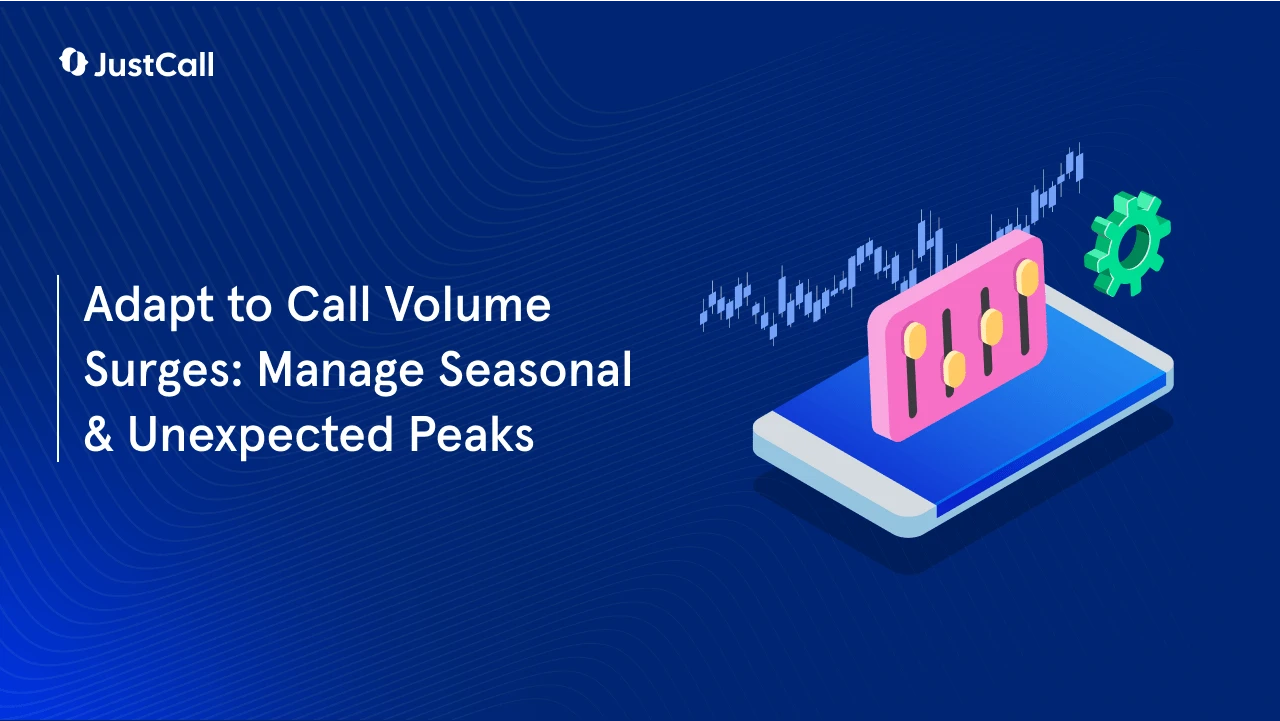Call center life can be a rollercoaster ride. One minute, your agents are cruising along; the next, they’re buried in a mountain of calls. These unpredictable ups and downs can be brutal for everyone involved. Stressed-out agents face burnout during peak times and feel underutilized when things slow down —– it’s not a recipe for success.
But fear not. There are some tried-and-tested strategies to help your call center weather these volume storms and keep things running smoothly. Let’s dive into some practical tips to conquer those call fluctuations!
TL;DR
| > Seasonal and unexpected call volume fluctuations can hamper your call center operations. Unexpected surges and drops are challenging and require proper management tools. So, what can you do during these phases? > To handle seasonal changes, you can utilize: – Accurate forecasting – Flexible staffing – Cross-training – Self-service options – Agent empowerment > Meanwhile, for unexpected fluctuations, you can employ: – Call monitoring – Dynamic routing – AI agents – Agile staffing – Overflow management > Using software like JustCall can help you manage seasonal and unforeseen call volume changes. |
What are seasonal and unexpected call volume fluctuations?
Call volume fluctuations in call centers refer to changes in the number of incoming calls received over a specific period. These fluctuations can vary in intensity and frequency, ranging from sudden surges to unexpected drops in call traffic.
What causes unexpected call volume fluctuations
- Seasonal trends: Certain times of the year, such as holidays or peak shopping seasons, may result in increased call volumes.
- Marketing campaigns: Successful marketing campaigns or promotions can lead to a sudden influx of calls.
- External events: Events such as product launches, service outages, or industry developments may trigger a surge in calls.
- Technical issues: System failures, website crashes, or other technical glitches can prompt customers to contact support. They do so for troubleshooting or resolution, leading to increased call volumes.
- Customer behavior: Changes in customer behavior, such as shifts in buying patterns or preferences, can impact call volumes. Customers reach out for assistance, feedback, or inquiries based on these changes.
Challenges faced as a result of fluctuations in call volume
- Staffing challenges: Seasonal peaks can lead to a mismatch between incoming call volumes and available agents. If agents are not available during a particular season and call volume peaks, it would result in missed calls and extended wait times. Both of these lead to customer frustration.
- Productivity concerns: An unexpected increase in call volumes can lead to decreased agent morale, demotivation, and burnout. This can impact the efficiency and productivity of the call center, affecting the quality of service provided to customers.
- Operational inefficiencies: Fluctuating call volumes can disrupt the call center’s operational flow. This leads to calling routing system inefficiencies, longer call times, and frustrated agents. These further result in customer dissatisfaction and increased operational costs.
- Brand reputation: During unexpected peaks, call centers may not have enough agents to attend to the incoming call volume. The extended wait times result in poor customer experiences, and negative feedback can harm a company’s reputation. Negative customer experiences impact customer retention rates and overall brand perception.
- Customer satisfaction: Customers are busy and they don’t want to wait till you answer the call. Also, when they get connected, they would expect their queries to be treated seriously and solved properly. Maintaining a consistent service quality and providing quality solutions, even during peak periods, can have a huge impact on customer satisfaction.
Read more: Manage high call volume with ease using IVR automation
Seven tips for managing seasonal and unexpected call fluctuations
Unexpected spikes and dips in call volumes are normal. However, not preparing for them can impact operations and customer experience. Here are seven proven tips to handle seasonal fluctuations:
1.Accurate demand forecasting
Use AI models to analyze historical data. This allows you to forecast future call volumes during different seasons. Accurate demand forecasting is the foundation for effective workforce planning. It allows you to schedule the right number of agents for each interval. This ensures you have enough staff during peaks without overstaffing during slumps.
2.Call monitoring
Install real-time call analytics dashboards. They detect unusual spikes or dips in call traffic across different queues or groups. Continuous monitoring helps identify and respond to unforeseen volume changes before they escalate.
3.Flexible staffing
Flexible scheduling helps scale up or down your workforce based on forecasted demands. Explore options like hiring temporary staff, allowing overtime, shift-bidding, and split shifts. This lets you ramp up capacity during peak periods and reduce headcount during dips, ensuring optimal usage of resources.
4.Cross-training agents
Cross-train agents on diverse products, processes, and queues well in advance. This ensures agents can handle queries across different skill sets. When call volumes surge in one area, you can move cross-trained staff from other queues for uninterrupted service delivery.
5.Self-service enablement
For self-service, you can deploy conversational IVRs, chatbots, FAQ sections, and help centers. These help direct simple queries to self-service channels, reducing the workload on live agents during peak volume periods. Instead, they can focus on resolving complex issues. Self-service also enhances customer convenience.
6.Agent empowerment
Provide agents with AI-assisted processes, easy-to-use knowledge bases, and relevant training programs. This empowers them to handle complex customer inquiries during peak call volumes. Up-to-date knowledge resources and smart capabilities boost agent productivity.
7.Overflow management
Utilize automated callbacks, virtual queues, and call routing to partners when call queues overflow. This way, callers don’t face long hold times or get disconnected during high spikes, preventing frustration.
Tackle call volume fluctuations with JustCall
Conquering fluctuating call volumes requires a well-rounded approach. While proactive planning helps address seasonal changes, remaining agile is essential for unforeseen spikes or dips.
The right technology solutions provide the required capabilities. That’s where JustCall can help.
With JustCall, you get all the essential tools, from AI-powered self-service to real-time analytics, workforce management, and more, all under one roof.
Don’t just take our word. Sign up for JustCall and explore how to manage fluctuating call volumes.












